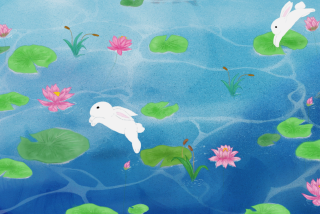Teacher Cottons to Rabbit Breeding : High School Instructor Pulls a New Career Out of Hat
- Share via
The brown and white bunny frolicking in a Pico Rivera backyard has rather an unusual name: Zhivago. But when you call his name, something even more extraordinary happens--he kicks up his heels and comes hopping over.
“There will never be another rabbit like him,” said Jean Sleeper, Zhivago’s owner and a rabbit breeder. “He’s a riot. He’s fantastically bred with a giant pedigree. But he’s such a pet, he’s just like a little dog.”
Zhivago is just one of the unique rabbits Sleeper has seen in nine years of rabbit breeding. “I’ve dealt with a lot of rabbits,” she said. “Their personalities are as different as there are people in the world. It’s incredible. Some are really picky, some as kicked back as you can get.”
One of Sleeper’s more mellow rabbits now belongs to a Beverly Hills hairdresser. The rabbit is housebroken and has the run of his salon. Clients are delighted . . . at least most of them. On one occasion, the usually well-behaved bunny munched a woman’s expensive dress shoe. The hairdresser had to foot the bill for new shoes.
Then there’s the quirky bunny sent to an Ohio rabbit breeder. Every morning the man feeds her first, and then she jumps onto his shoulder. She stays perched there as he goes throughout the rabbitry, feeding all the other rabbits.
Received Numerous Grants
And then there’s Lewis & Clark. Lewis is the magician, Clark the rabbit in the hat. Together, they’re an act that has played many clubs, including the Magic Castle.
If these rabbits sound remarkable, so is Jean Sleeper. A science teacher at Los Alamitos High School, she has a master’s degree in biology and has won the prestigious Southern California Academy of Science Research Award. She’s received numerous grants, including four from the National Science Foundation. Sleeper had bred both horses and dogs for show, but it was a bunny named Razzle who got her involved with rabbits.
“My best friend worked at a vet’s office,” she recalls. “A couple brought in the rabbit, which was paralyzed from being attacked by a dog. The owners paid the vet bill, about $200, but the vet also told them they’d need to work with the rabbit every day to rehabilitate it. They couldn’t do that--both were working and they had a small child. So my friend brought Razzle to me in a laundry basket and said, ‘You can’t refuse this, can you?’ ”
She couldn’t, and Sleeper decided to start a 4-H Club at her high school, with Razzle as the first project.
Intrigued by Genetics
The recovery took months. For a long time, Razzle just lay on his side and munched a few blades of grass. But by the third month he was taking some tentative hops. Razzle completely recovered, although his head was always canted at an angle, and one ear remained crooked. The 4-H Club put together an exhibit on Razzle, documenting his convalescence, which won awards at the 1979 County Fair. It was at this point that Sleeper decided to get into show rabbits.
She began with Holland dwarf rabbits, so-named because they’re originally from Holland and are the smallest breed in the world. “Their genetics intrigued me,” explained Sleeper. “The dwarf gene is dominant, which is very unusual. If a baby inherits a dwarf gene from both parents, it will die. If it inherits only one gene, you get a dwarf--which is what you want. If it doesn’t get either gene, you don’t have a dwarf rabbit.”
Sleeper won all the top show championships with her dwarfs, and then moved on to another breed she found more challenging: Holland lops. Lops are rabbits with ears that go down, not up.
“Lops are known for their mellow dispositions,” Sleeper said, “but they’re difficult because the breed itself isn’t well established. It may be 10 years before it’s perfected.”
Shortly after rehabilitating Razzle, Sleeper had an accident of her own with some striking parallels. Her horse took a jump wrong, and tumbled to the ground, crushing her. Back injuries left her paralyzed. She was alone, and couldn’t work or get around. Only after a risky operation a year later was she able to walk again. Yet, she doesn’t regret the experience.
“It teaches you a lot of respect for life and also for where other people are. You learn what it is to be handicapped. I’ve recovered, but there are a lot of others who haven’t.”
Sleeper found her animals helpful during her injury and recovery. “If I hadn’t had my pets, I don’t know what I would have done. They’re always there by your side, always happy, and it gives you something to live for . . . I really think that’s true. And I try to do things for animals now because they helped me out a lot.”
One of the things she does is give advice on animals to anyone who asks her. “My vet always calls me when he gets a rabbit in,” she said. “They aren’t so familiar with rabbits as with cats and dogs.” And most pet stores, too, know little about them. “Often they give out the wrong information. I see a lot of problems with improper diets and cages that are too small for the animals--that’s the worst problem. And a lot of pet shops shove sick animals in with the healthy ones, because they don’t know what they’re doing.”
More to Read
Sign up for Essential California
The most important California stories and recommendations in your inbox every morning.
You may occasionally receive promotional content from the Los Angeles Times.










